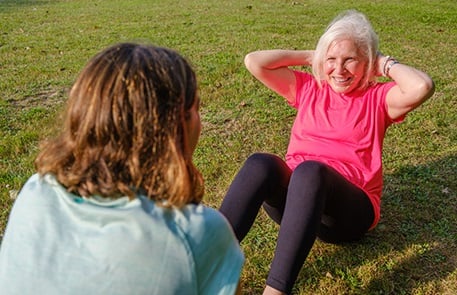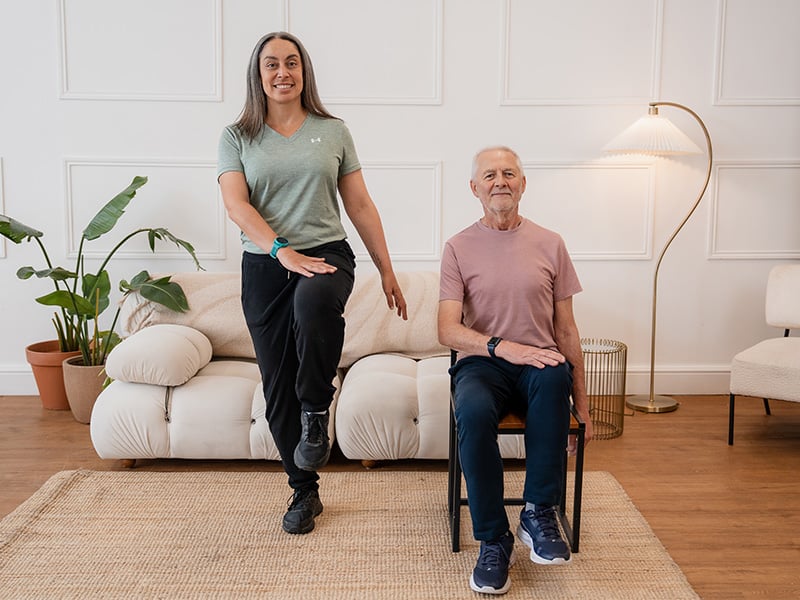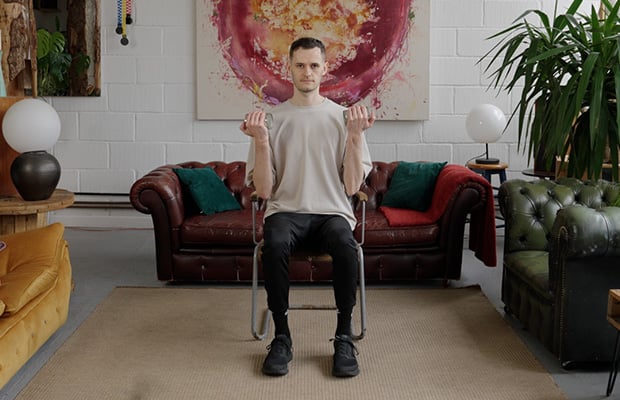
Best compound exercises to help you lose weight
Regular exercise is an important part of your weight loss journey, says Cardiac Rehab expert Hara Markos. She shares 4 effective compound exercises: squats, press ups, deadlifts and shoulder presses for varying fitness levels you can try at home.




On this page

Staying active comes with plenty of benefits for your heart – including helping to manage your weight.
If you’re living with excess weight or obesity, losing weight can reduce your risk of having a heart attack or stroke.
And certain exercises can be particularly effective for weight loss when combined with a healthy diet.
Here’s a guide to some of my favourite exercises to help you lose weight, as well as tips on how to progress as you get fitter.
How exercise can help you lose weight
To lose weight, you need to burn more energy (calories) than you consume. You can do this by eating a healthy diet that’s low in calories and doing more exercise.
The recommended daily calorie intake is 2,000kcal for women and 2,500kcal for men.
If you want to lose weight, reducing your daily calorie intake by about 600 calories can help you do so safely.
Exercising can also help you burn more energy, but it would take most people several hours of walking to burn an extra 600 calories every day.
That’s why combining a balanced, diet with regular physical activity is the most effective approach for sustainable weight loss – this approach is backed up by research.
But, as well as using up calories, staying active also helps you maintain and build muscle, which can boost your metabolism – or how many calories you burn every day.
The best exercises to lose weight
The UK government recommends aiming for at least 150 minutes of moderate intensity activity per week, or just over 20 minutes a day.
This could be brisk walking, swimming, gardening or following exercise videos. You can break this up into a few 10-minute sessions throughout your day.
Moderate intensity aerobic exercise makes you feel warm and breathe a bit faster, but you should still be able to talk.
However, if you’re trying to lose weight, you may want to exercise more than this to use up more energy and burn more calories.
The government also recommends doing strength (resistance) training at least 2 times a week.
This refers to any exercise that makes your muscles stronger, such as carrying heavy shopping bags, yoga or lifting your own bodyweight.
While strength training does not burn as many calories as aerobic exercise, it can help you build muscle and increase how much energy your body uses at rest.
But it’s not just formal exercise that can help you burn calories. You also use up energy when you move around in your daily life. This includes walking, standing, cleaning and cooking.
Adding more movement to your daily routine can make a big difference over time. Taking the stairs, parking your car further away from the shops, or simply standing up and moving around if you’ve been sitting down for a while, can all help.
- Discover 9 easy ways to exercise at home.
Compound exercises help with weight loss
A compound exercise is a movement that uses lots of different muscles and joints at the same time, such as squats and press ups.
They use up more energy than exercises that only target a single muscle group, like bicep curls or calf raises.
If you’re trying to lose weight, compound exercises can be an efficient way to burn calories and build muscle at the same time.
They’re also more similar to the movements you make in your daily life. This means they can help to prevent injuries and make everyday activities feel easier.
Your exercise plan to help with weight loss
If you’d like to add more compound movements to your routine, you can get started with the 4 exercises I’ve listed below – a squat, press up, deadlift and shoulder press – which work lots of different muscles across your body.
Each exercise has 4 levels, starting with variations for beginners before working up to more advanced movements.
You can choose to do each exercise sitting down or standing up, with added weights, or just with your bodyweight.
Aim to do each exercise 12 to 16 times, rest for 2 to 3 minutes, and then repeat 2 to 3 times. You can do this workout 2 to 3 times a week.
When the exercise starts to feel easy, try moving up to the next level. You may not be able to repeat the exercise as many times but still aim for 12 to 16 repetitions.
Remember to warm up before you start exercising, and cool down afterwards.
If you have a heart condition, high blood pressure or type 2 diabetes, make sure to check with your doctor before you start exercising or using any weights.
And if you feel unwell or notice any chest pain while you’re exercising, stop immediately and speak to your doctor.
4 compound exercises for all fitness levels
1. Squat
This classic lower-body exercise works the muscles in your legs, bottom (glutes) and core.
Level 1: sit to stand

- Sit on a chair with your feet hip-width apart and cross your arms over your chest. A higher chair will make the exercise easier, while a lower chair will be more difficult.
- Exhale to stand up.
- Inhale to slowly sit back down again.
- Repeat 12 to 16 times.
Level 2: squat without a chair

- Stand with your feet hip-width apart. Cross your arms over your chest or put your hands on your hips.
- Inhale to lower your hips. Try to go as low as your joints will allow.
- Exhale to slowly stand up again.
- Repeat 12 to 16 times.
Level 3: squat with weights

- Stand with your feet hip-width apart. Hold a bottle of water, food can or dumbbell in each hand by your sides, or a heavier weight with both hands at your chest.
- Inhale to lower your hips, keeping your arms by your side.
- Exhale to slowly stand up again.
- Repeat 12 to 16 times.
Level 4: squat with curls

- Stand with your feet hip-width apart. Hold a bottle of water, food can or dumbbell in each hand by your sides, or a heavier weight with both hands at your chest.
- Inhale to lower your hips, keeping your arms by your side.
- Exhale to slowly stand up again.
- Bend your elbows to lift the weights up towards your chest and perform a bicep curl.
- Drop your hands back down to your sides.
- Repeat the entire movement 12 to 16 times.
2. Press up
A press up can build strength in the chest, shoulders and arms. It’s an advanced exercise, but there are modifications that can make it more achievable.
Level 1: chest press

- Sit or stand with your feet hip-width apart.
- Bring your elbows up and out to the sides with your knuckles facing forward.
- Press your hands forward until your arms are nearly straight in front of you.
- Slowly bring your arms back to the starting position.
- Repeat 12 to 16 times.
Next step: Hold weights like a bottle of water, food can or dumbbell in each hand, or try the exercise with a resistance band.
Level 2: wall press up

- Stand a few feet away from a wall and place your hands on the wall at around chest height with your elbows slightly bent. Standing further away will increase the resistance.
- Lean forward towards the wall while bending your elbows and keeping your back and legs straight.
- Slowly straighten your arms and push yourself away from the wall back to your starting position.
- Repeat 12 to 16 times.
Level 3: incline press up

- Get on your hands and knees and place your hands on a stable raised surface, such as a kitchen counter, chair or box, with your arms straight and your back and legs fully extended behind you. Leaning on a surface that’s lower down will increase the resistance.
- Lean forwards while bending your elbows and keeping your back and legs straight.
- Slowly straighten your arms and push yourself away from the raised surface back to your starting position.
- Repeat 12 to 16 times.
Level 4: kneeling press up

- Get on your hands and knees on a mat, keeping your back straight at a 45-degree angle.
- Lean forwards towards the ground with your hands slightly wider than shoulder-width apart in line with your chest while bending your elbows and keeping your back straight.
- Slowly straighten your arms and push yourself back up to your starting position.
- Repeat 6 to 8 times.
Next step: Lift your knees off the floor and extend your legs behind you to perform a full press up.
3. Deadlift
A deadlift targets all the muscles down the back of your body, which includes your back, glutes, hamstrings and core.
Level 1: seated deadlift

- Sit on a chair with your legs wider than your hips and your back straight and put your hands by your temples.
- Lean forward at the hips until you feel the muscles on the back of your legs being pulled, keeping your back straight.
- Slowly sit back up, pushing your feet into the floor.
- Repeat 12 to 16 times.
Next step: Hold a weight in both hands in between your legs.
Level 2: standing deadlift

- Stand with your feet hip-width apart and your hands by your temples, keeping your knees soft.
- Lean forward at the hips until you feel the muscles on the back of your legs being pulled, keeping your back straight.
- Slowly stand back up, pushing your feet into the floor.
- Repeat 12 to 16 times.
Level 3: broom handle deadlift

- Stand with your feet hip-width apart and hold a long stick like a broom handle in both hands.
- Lean forward at the hips and lower the broom handle towards your knees, keeping your back and arms straight, until you feel the muscles on the back of your legs being pulled.
- Slowly stand back up, pushing your feet into the floor.
- Repeat 12 to 16 times.
Level 4: deadlift with weights

- Stand with your feet hip-width apart and hold weights such as a bottle of water, food can or dumbbell in each hand.
- Lean forward at the hips and lower the weights towards your knees in a straight line, keeping your back and arms straight, until you feel the muscles on the back of your legs being pulled.
- Slowly stand back up, pushing your feet into the floor.
- Repeat 12 to 16 times.
4. Shoulder press
A shoulder press is another effective way to build strength in your upper body, targeting your shoulders, upper back and arms. You can move one arm at a time, or both at once.
Level 1: seated bodyweight shoulder press

- Sit with your feet hip-width apart with your elbows at your sides and your hands at shoulder-height.
- Push both arms straight into the air until they are fully extended.
- Slowly lower your arms back to the starting position.
- Repeat 12 to 16 times.
Level 2: seated shoulder press with weights

- Sit with your feet hip-width apart with your elbows at your sides and your hands at shoulder-height, holding a weight such as a bottle of water, food can or dumbbell in each hand.
- Push both arms straight into the air above you until they are fully extended. Keep your palms facing forward and elbows slightly in front of your body as you move your arms up.
- Slowly lower your arms back to the starting position.
- Repeat 12 to 16 times.
Level 3: standing bodyweight shoulder press

- Stand with your feet hip-width apart with your elbows at your sides and your hands at shoulder-height.
- Push both arms straight into the air until they are fully extended. Keep your palms facing forward and elbows slightly in front of your body as you move your arms up.
- Slowly lower your arms back to the starting position.
- Repeat 12 to 16 times.
Level 4: standing shoulder press with weights

- Stand with your feet hip-width apart with your elbows at your sides and your hands at shoulder-height, holding a weight such as a bottle of water, food can or dumbbell in each hand.
- Push both arms straight into the air until they are fully extended. Keep your palms facing forward and elbows slightly in front of your body as you move your arms up.
- Slowly lower your arms back to the starting position.
- Repeat 12 to 16 times.
What to read next..





